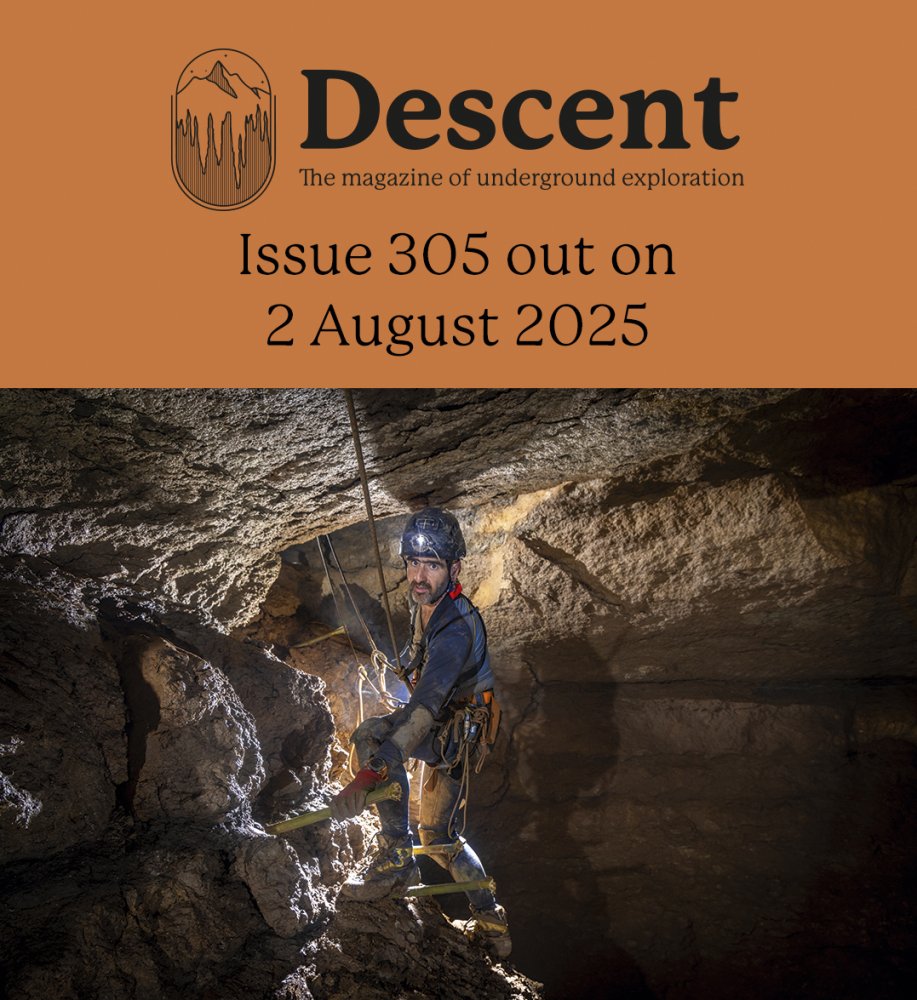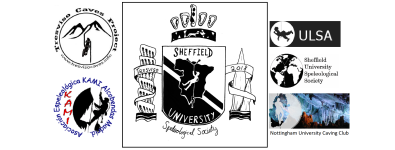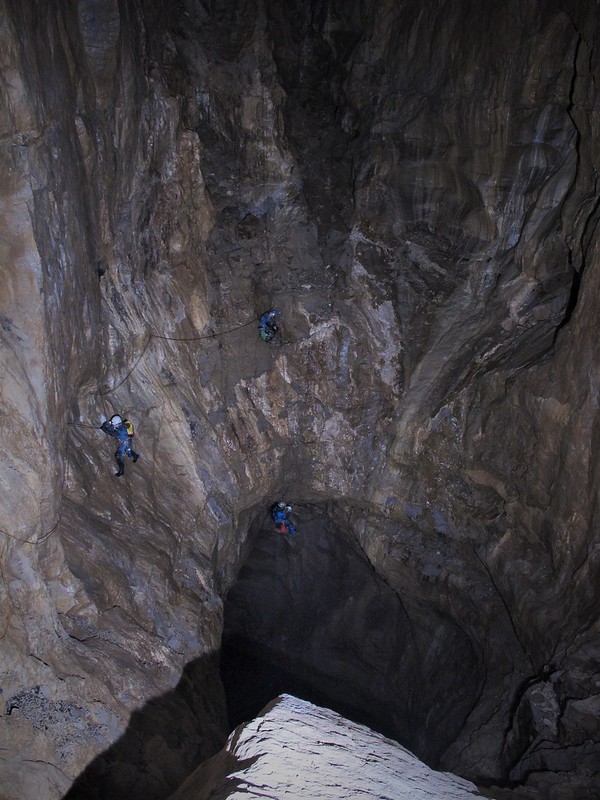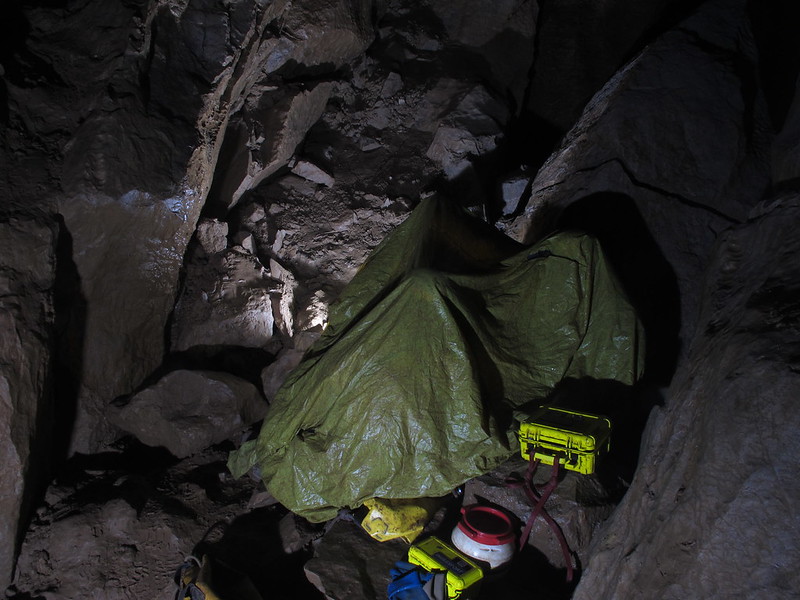not_a_climber
New member
The Tresviso Caves Project is a long running expedition to the Picos de Europa in Northern Spain, which this year will consist of two teams, with one mainly comprised of members from Sheffield University Speleological Society. We hope that these teams will allow us to push the already 11km-long Cueva del Agua further towards the goal of a record breaking 1.5km deep through-trip, by connecting to the higher altitude systems of the Andara region.
History of the Tresviso Caves Project
The Parc Nacional de los Picos de Europa sits just inland from the Northern coast of Spain, part of the Cantabrian Mountains. This region of carboniferous limestone is home to several exploratory caving projects involving British cavers, including the Ario Cave Projects.

The location of the Tresviso area in the Eastern Massif of the Picos (Andara)
Perhaps less well known is the Tresviso Caves Project, an ongoing exploratory effort in the Andara region of the Picos de Europa which was begun in the 1970s by student cavers from Lancaster University. In the early expeditions, [acronym=Lancaster University Speleological Society]LUSS[/acronym] pushed Cueva del Agua to 11km total length and +392m. Later in the 70?s and 80?s their attention turned to entrances higher in the mountains that could possibly drop into the same system. Several deep caves were pushed including Sara (-635m), Tere (-792m) Dossers Delight (-831m) and Flowerpot (-720m). However the most promising connection seemed to be Sima 56 which was concluded in 1985 at -1169m deep, overlapping in height with Agua but around 3km distant horizontally. If connected, this route could form a record breaking 1.5km-deep through trip.
After [acronym=Lancaster University Speleological Society]LUSS[/acronym] activity died off in the mid-1990s, exploration was continued by several Spanish clubs including AD KAMI, and [acronym=South Wales Caving Club]SWCC[/acronym] members from the UK. From 2009, annual expeditions have made a concerted effort to push unexplored shafts in the Sierra del Corta, an area that sits above the furthest point of Cueva del Agua, as well as rebolting and rigging Cueva del Agua and pushing leads, including climbing Death Race 2000, the furthest point in the cave, which has led to several extensions. This reinvigorated effort led to the creation of the Tresviso Caves Project in 2015 as a joint venture between a number of UK clubs and the Spanish club AD KAMI.

Pozo Castillo on the 2017 expedition
2018 Expedition
This year, the [acronym=Tresviso Caves Project]TCP[/acronym] group will be joined by a group of Sheffield University cavers conducting a side expedition. These teams will run alongside each other from 1st-15th September 2018 with a total of around 50 cavers pushing various projects. [acronym=Sheffield University Speleological Society]SUSS[/acronym] are taking around 25 cavers, with as many as 8 new-to-expedition cavers.
As such, this provides an excellent opportunity for [acronym=Sheffield University Speleological Society]SUSS[/acronym], who have not run an expedition of this scale or ambition for several years, the opportunity to be supported through our more experienced members as well as through the experience of the Tresviso Caves Project. As well as exploratory aims, we are considering of equal importance our aim to come away from the expedition with a more cohesive club and more well trained cavers. This will not only be achieved during the expedition but we are also pushing pre-exped training as a priority to get everyone up to scratch before we go.
Utilising the capacity of having two teams, this years expedition aims to push the caves in the region from two directions - the TCP cavers pushing Agua from the bottom up and [acronym=Sheffield University Speleological Society]SUSS[/acronym] camping higher in the mountains to push down. The large number of cavers in the [acronym=Sheffield University Speleological Society]SUSS[/acronym] team will allow us to push several objectives. Our aim is to use a more experienced team to push a deep system with many less committing projects for those with less experience.
Primary objectives for [acronym=Sheffield University Speleological Society]SUSS[/acronym] team:
Pico Boro area
General surface sweep especially of lower slopes and logging entrances.
Flowerpot (-720m) - Re-bolt and rig after last exploration in the 80?s. Push multiple climbing leads throughout system as well as unexplored side passages.
T207 and Torca Septrin - vertical systems (circa -120m deep) ending in narrow, draughting passages - could be capped or pushed by skinny people.
Sierra del Corta
Surface sweep in awkward terrain to log entrances.
T554 & T291 - Both very close to top end of Agua. T554 is 120m shaft from surface to tight continuation. T291 undescended beyond entrance.
Sara
Various high level entrances that need surveying and linking into the wider Sara mine complex, with unexplored levels and potential deeper pitches.
Secondary objectives:
Mazarassa leads
Original entrance has collapsed, but there are potentially 3 further entrances, via mine levels that may connect and will allow re-exploration.
Castillo system
Pozo Natacha - -309m system with a tight constriction above final undescended 20m pitch,
T334 - 7 second drop still undescended, may link into Castillo system.
Other:
T225 Torca Bromista - incredibly tight entrance series but draughting at the bottom.
T516 Cowshed Cavern - 3 climbs from main streamway, potential dig and surface work
T47a Valdediezma - draughting hole but may be hidden by trees.
Agua - Pottery Kiln - strong breeze through spoil, likely to break out onto quite inaccessible mountainside but could provide alternative flood entrance to Agua.
Hoyo Oscuro & Hoyo Evangelista - surface sweep and logging of entrances above 1800m, any leads here would be interesting in wider picture.
Rope requirements:
We plan to rig Flowerpot (-720m) for the duration of the exped while pushing leads here and in other locations, so plan on needing around 1000m of rope. Therefore the contribution from the UKC rope sponsorship would be a significant portion of this and reduce our costs significantly (which for a student exped is key!)
Pre-exped plans for [acronym=Sheffield University Speleological Society]SUSS[/acronym] team
From now until the exped we have three training weekends planned. The first will be held in Derbyshire and will encourage members to join the DCRO rescue training, along with other rescue and rigging training for others. The July weekend will be held in the Dales and hopes to train some members in the use of our Sked stretcher with the help of Martin Holroyd. The final pre-exped weekend in August will be held in South Wales and will be a practice of various exped ?dry-skills? such as putting up the mess tent and cooking, and checking over everyones equipment.

SUSS training on stretcher hauling at the YSS
There is an established TCP blog which can be found here:
www.tresvisocaves.info/blog/
We will use this blog, and the thread here on UKC, to keep a record of our pre-exped plans as well as during and after the exped to record our explorations. We also hope to publish an interactive map with entrance locations linked to any available pictures and surveys before the expedition, to be added to afterwards. There is also more information about the history of exploration in Tresviso with surveys, previous reports and cave details on http://www.tresvisocaves.info.
SUSS are really looking forward to this expedition, and are very grateful to TCP for their ongoing support in our exped planning, and we look forward to sharing our results with the wider British caving community. We hope that blogging throughout the exped and producing a journal afterwards will help our aim of establish a long lasting link between the Tresviso Caves Project and Sheffield University Speleological Society by encouraging future members through our exploits.

History of the Tresviso Caves Project
The Parc Nacional de los Picos de Europa sits just inland from the Northern coast of Spain, part of the Cantabrian Mountains. This region of carboniferous limestone is home to several exploratory caving projects involving British cavers, including the Ario Cave Projects.

The location of the Tresviso area in the Eastern Massif of the Picos (Andara)
Perhaps less well known is the Tresviso Caves Project, an ongoing exploratory effort in the Andara region of the Picos de Europa which was begun in the 1970s by student cavers from Lancaster University. In the early expeditions, [acronym=Lancaster University Speleological Society]LUSS[/acronym] pushed Cueva del Agua to 11km total length and +392m. Later in the 70?s and 80?s their attention turned to entrances higher in the mountains that could possibly drop into the same system. Several deep caves were pushed including Sara (-635m), Tere (-792m) Dossers Delight (-831m) and Flowerpot (-720m). However the most promising connection seemed to be Sima 56 which was concluded in 1985 at -1169m deep, overlapping in height with Agua but around 3km distant horizontally. If connected, this route could form a record breaking 1.5km-deep through trip.
After [acronym=Lancaster University Speleological Society]LUSS[/acronym] activity died off in the mid-1990s, exploration was continued by several Spanish clubs including AD KAMI, and [acronym=South Wales Caving Club]SWCC[/acronym] members from the UK. From 2009, annual expeditions have made a concerted effort to push unexplored shafts in the Sierra del Corta, an area that sits above the furthest point of Cueva del Agua, as well as rebolting and rigging Cueva del Agua and pushing leads, including climbing Death Race 2000, the furthest point in the cave, which has led to several extensions. This reinvigorated effort led to the creation of the Tresviso Caves Project in 2015 as a joint venture between a number of UK clubs and the Spanish club AD KAMI.

Pozo Castillo on the 2017 expedition
2018 Expedition
This year, the [acronym=Tresviso Caves Project]TCP[/acronym] group will be joined by a group of Sheffield University cavers conducting a side expedition. These teams will run alongside each other from 1st-15th September 2018 with a total of around 50 cavers pushing various projects. [acronym=Sheffield University Speleological Society]SUSS[/acronym] are taking around 25 cavers, with as many as 8 new-to-expedition cavers.
As such, this provides an excellent opportunity for [acronym=Sheffield University Speleological Society]SUSS[/acronym], who have not run an expedition of this scale or ambition for several years, the opportunity to be supported through our more experienced members as well as through the experience of the Tresviso Caves Project. As well as exploratory aims, we are considering of equal importance our aim to come away from the expedition with a more cohesive club and more well trained cavers. This will not only be achieved during the expedition but we are also pushing pre-exped training as a priority to get everyone up to scratch before we go.
Utilising the capacity of having two teams, this years expedition aims to push the caves in the region from two directions - the TCP cavers pushing Agua from the bottom up and [acronym=Sheffield University Speleological Society]SUSS[/acronym] camping higher in the mountains to push down. The large number of cavers in the [acronym=Sheffield University Speleological Society]SUSS[/acronym] team will allow us to push several objectives. Our aim is to use a more experienced team to push a deep system with many less committing projects for those with less experience.
Primary objectives for [acronym=Sheffield University Speleological Society]SUSS[/acronym] team:
Pico Boro area
General surface sweep especially of lower slopes and logging entrances.
Flowerpot (-720m) - Re-bolt and rig after last exploration in the 80?s. Push multiple climbing leads throughout system as well as unexplored side passages.
T207 and Torca Septrin - vertical systems (circa -120m deep) ending in narrow, draughting passages - could be capped or pushed by skinny people.
Sierra del Corta
Surface sweep in awkward terrain to log entrances.
T554 & T291 - Both very close to top end of Agua. T554 is 120m shaft from surface to tight continuation. T291 undescended beyond entrance.
Sara
Various high level entrances that need surveying and linking into the wider Sara mine complex, with unexplored levels and potential deeper pitches.
Secondary objectives:
Mazarassa leads
Original entrance has collapsed, but there are potentially 3 further entrances, via mine levels that may connect and will allow re-exploration.
Castillo system
Pozo Natacha - -309m system with a tight constriction above final undescended 20m pitch,
T334 - 7 second drop still undescended, may link into Castillo system.
Other:
T225 Torca Bromista - incredibly tight entrance series but draughting at the bottom.
T516 Cowshed Cavern - 3 climbs from main streamway, potential dig and surface work
T47a Valdediezma - draughting hole but may be hidden by trees.
Agua - Pottery Kiln - strong breeze through spoil, likely to break out onto quite inaccessible mountainside but could provide alternative flood entrance to Agua.
Hoyo Oscuro & Hoyo Evangelista - surface sweep and logging of entrances above 1800m, any leads here would be interesting in wider picture.
Rope requirements:
We plan to rig Flowerpot (-720m) for the duration of the exped while pushing leads here and in other locations, so plan on needing around 1000m of rope. Therefore the contribution from the UKC rope sponsorship would be a significant portion of this and reduce our costs significantly (which for a student exped is key!)
Pre-exped plans for [acronym=Sheffield University Speleological Society]SUSS[/acronym] team
From now until the exped we have three training weekends planned. The first will be held in Derbyshire and will encourage members to join the DCRO rescue training, along with other rescue and rigging training for others. The July weekend will be held in the Dales and hopes to train some members in the use of our Sked stretcher with the help of Martin Holroyd. The final pre-exped weekend in August will be held in South Wales and will be a practice of various exped ?dry-skills? such as putting up the mess tent and cooking, and checking over everyones equipment.
SUSS training on stretcher hauling at the YSS
There is an established TCP blog which can be found here:
www.tresvisocaves.info/blog/
We will use this blog, and the thread here on UKC, to keep a record of our pre-exped plans as well as during and after the exped to record our explorations. We also hope to publish an interactive map with entrance locations linked to any available pictures and surveys before the expedition, to be added to afterwards. There is also more information about the history of exploration in Tresviso with surveys, previous reports and cave details on http://www.tresvisocaves.info.
SUSS are really looking forward to this expedition, and are very grateful to TCP for their ongoing support in our exped planning, and we look forward to sharing our results with the wider British caving community. We hope that blogging throughout the exped and producing a journal afterwards will help our aim of establish a long lasting link between the Tresviso Caves Project and Sheffield University Speleological Society by encouraging future members through our exploits.






